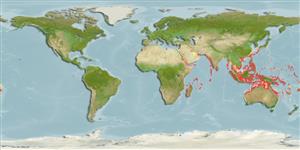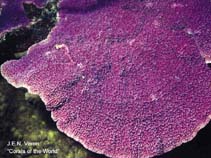Montipora monasteriata (Forsskål, 1775)
| Native range | All suitable habitat | Point map | Year 2050 |

|
| This map was computer-generated and has not yet been reviewed. |
| Montipora monasteriata AquaMaps Data sources: GBIF OBIS |
Classification / Names Common names | Synonyms | CoL | ITIS | WoRMS
Anthozoa | Scleractinia | Acroporidae
Environment: milieu / climate zone / depth range / distribution range Ecology
Reef-associated; depth range 0 - 48 m (Ref. 101963). Tropical; 36°N - 34°S, 27°E - 176°W (Ref. 846)
Distribution Countries | FAO areas | Ecosystems | Occurrences | Introductions
Indo-Pacific. Tropical to subtropical.
Length at first maturity / Size / Weight / Age
Maturity: Lm ? range ? - ? cm
Short description Morphology
Colonies are massive or are unifacial or bifacial thick plates which may be tiered in large colonies. Corallites: mostly immersed. Coenosteum: covered with papillae and/or tuberculae. Pale brown or blue; with blue or white margins (Ref. 846).
Life cycle and mating behavior Maturity | Reproduction | Spawning | Eggs | Fecundity | Larvae
Hermaphroditic (Ref. 113712). Mature gametes are shed into the coelenteron and spawned through the mouth. Life cycle: The zygote develops into a planktonic planula larva. Metamorphosis begins with early morphogenesis of tentacles, septa and pharynx before larval settlement on the aboral end (Ref. 833).
Main reference
References | Coordinator | Collaborators
Veron, J.E.N. 2000. (Ref. 846)
IUCN Red List Status (Ref. 130435)
Least Concern (LC) ; Date assessed: 03 January 2008
CITES status (Ref. 108899)
Appendix II: International trade monitored
CMS (Ref. 116361)
Not Evaluated
Threat to humans
Human uses
| FishSource |
Tools
More information
Internet sources
BHL | BOLD Systems | CISTI | DiscoverLife | FAO(Publication : search) | Fishipedia | GenBank (genome, nucleotide) | GloBI | Gomexsi | Google Books | Google Scholar | Google | PubMed | Hexacorallians of the World | Tree of Life | Wikipedia (Go, Search) | Zoological Record
Estimates based on models
Preferred temperature
(Ref. 115969): 24.7 - 29.1, mean 28.1 (based on 1470 cells).
Price category
(Ref. 80766):
Unknown.



